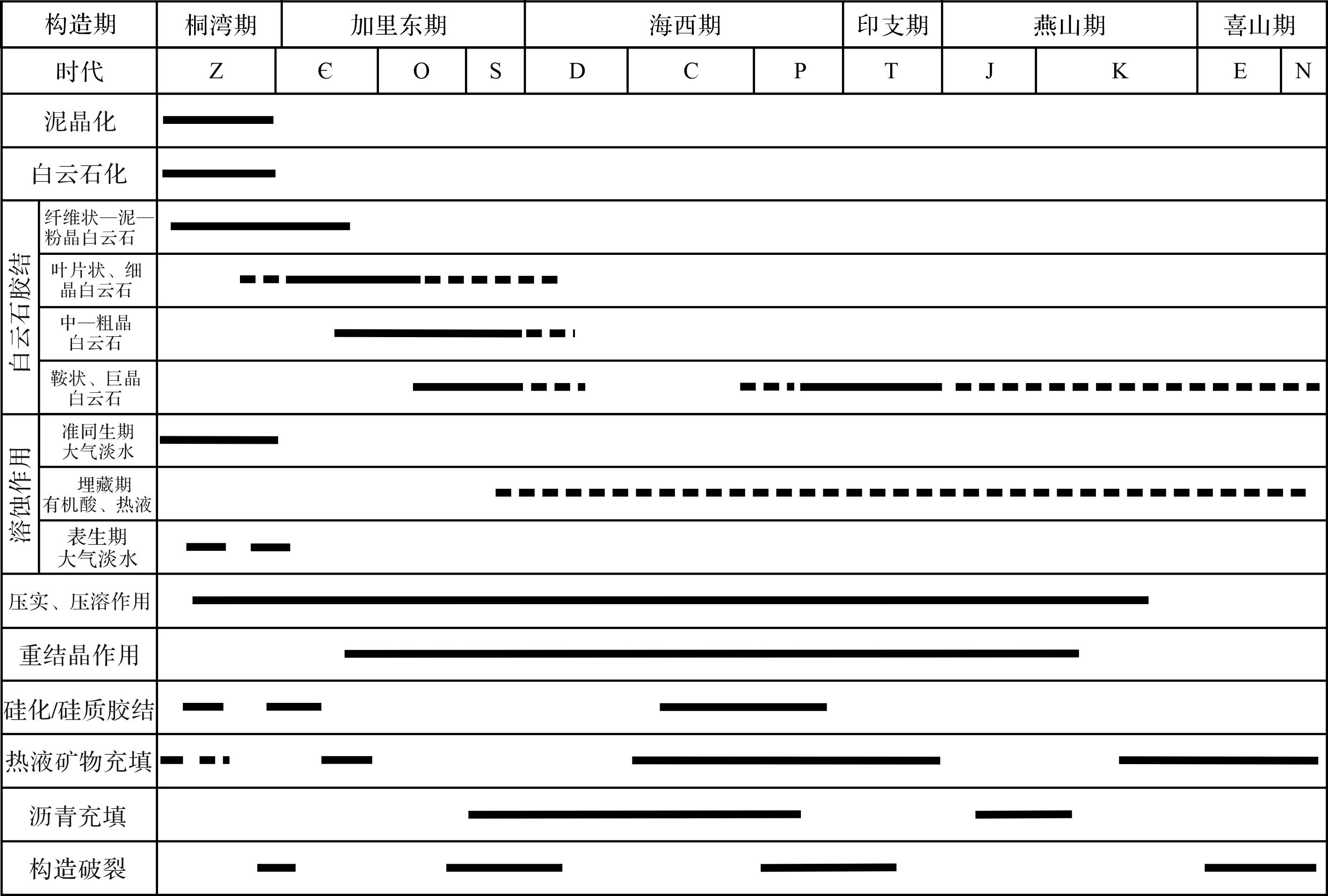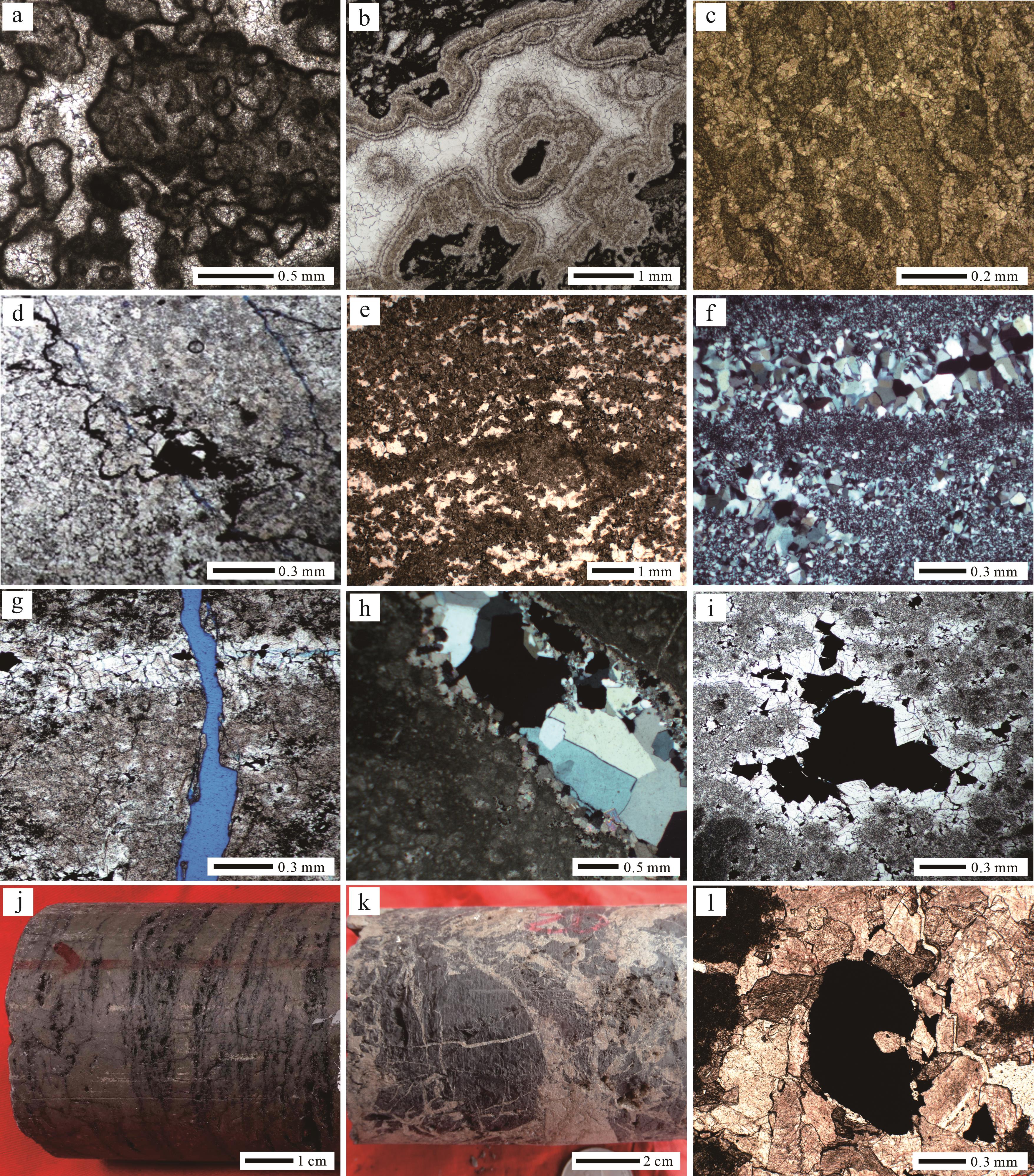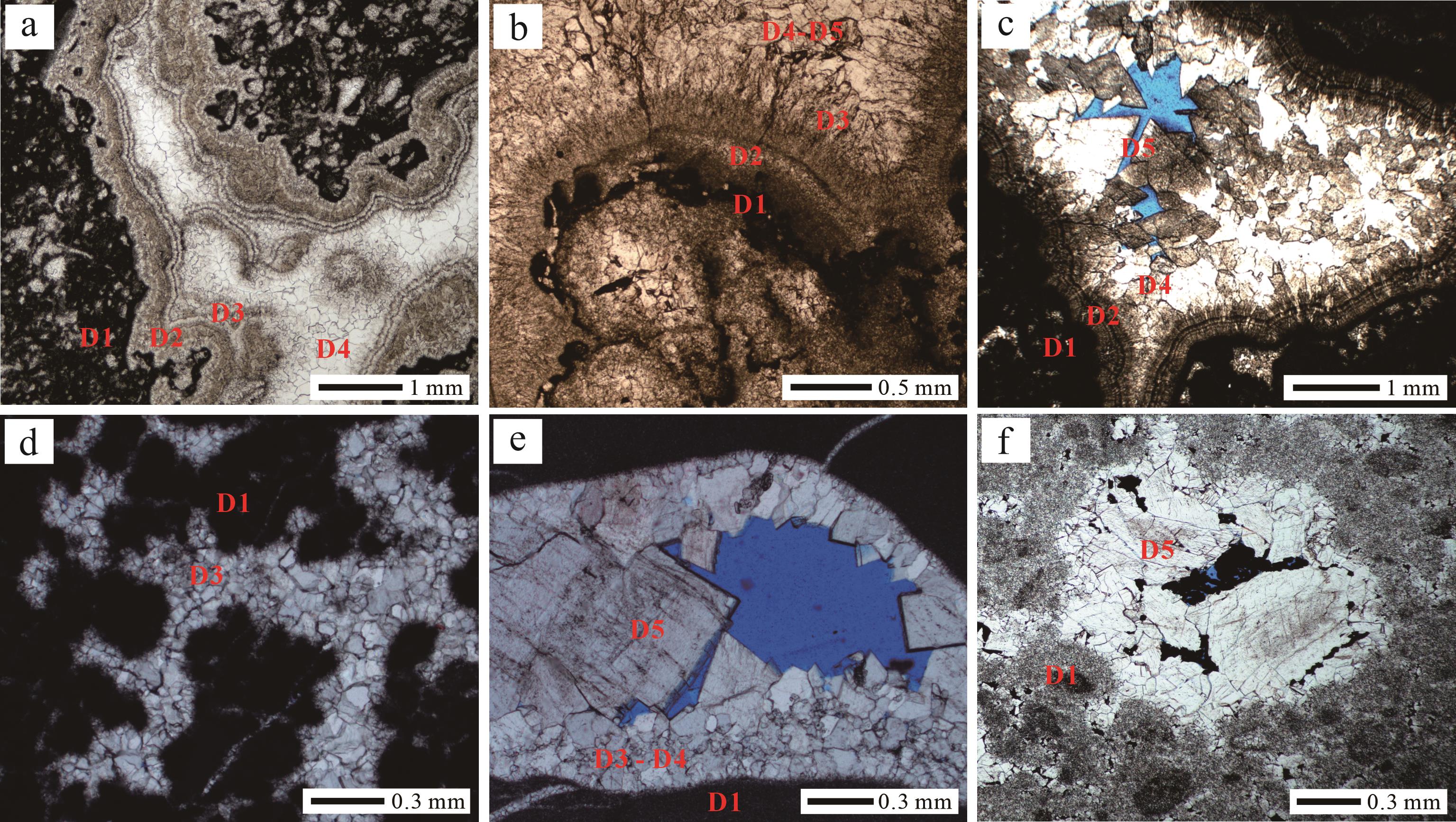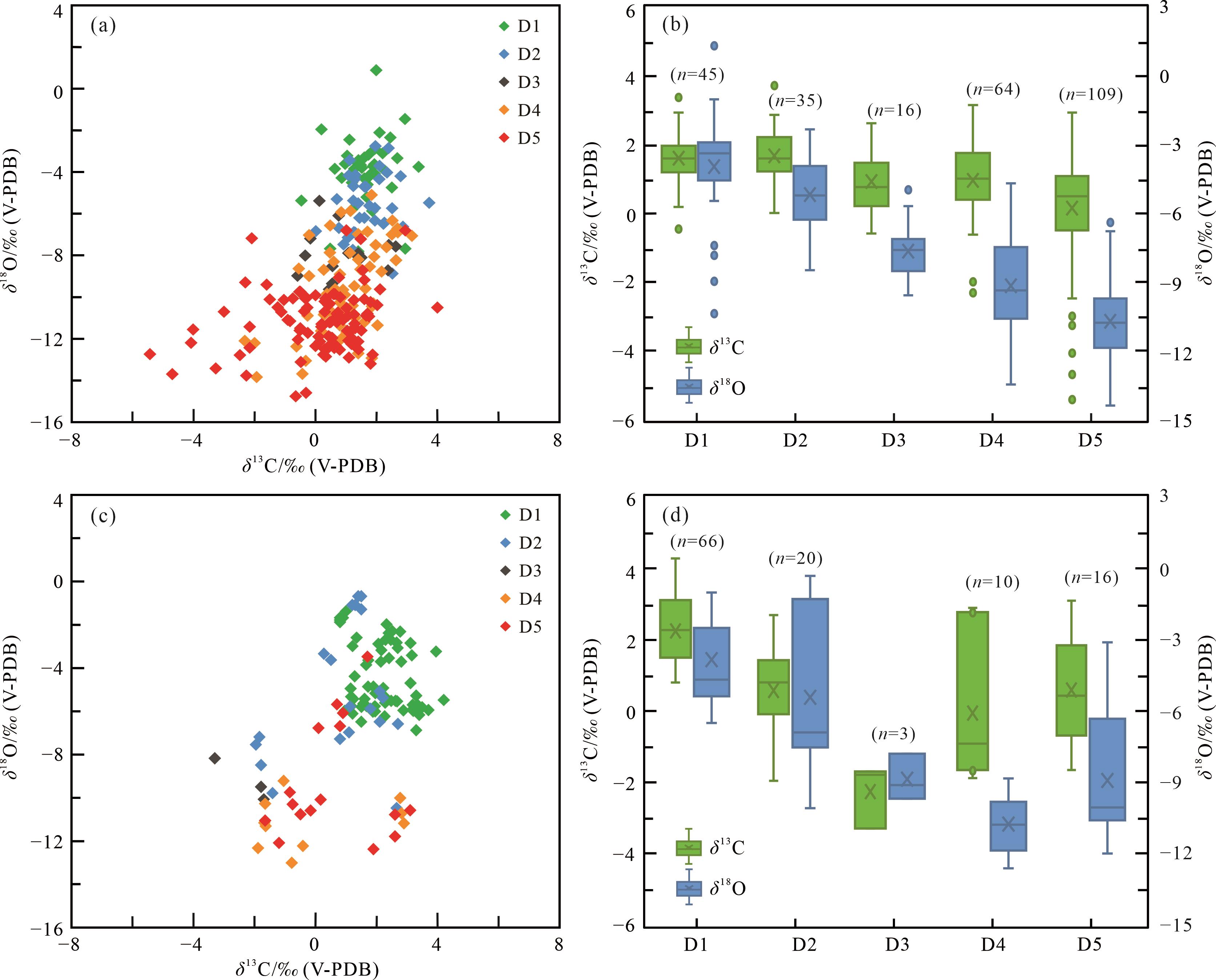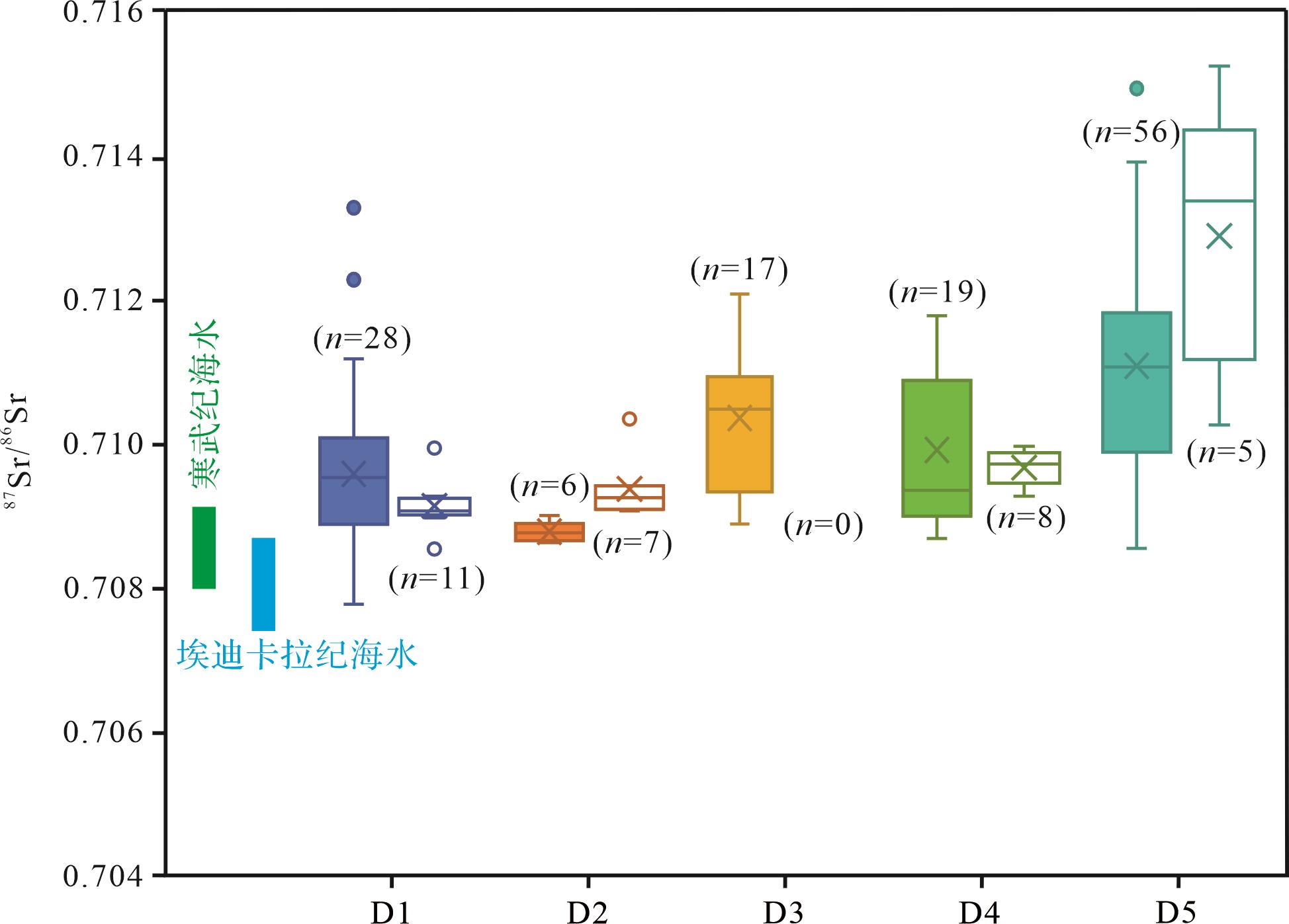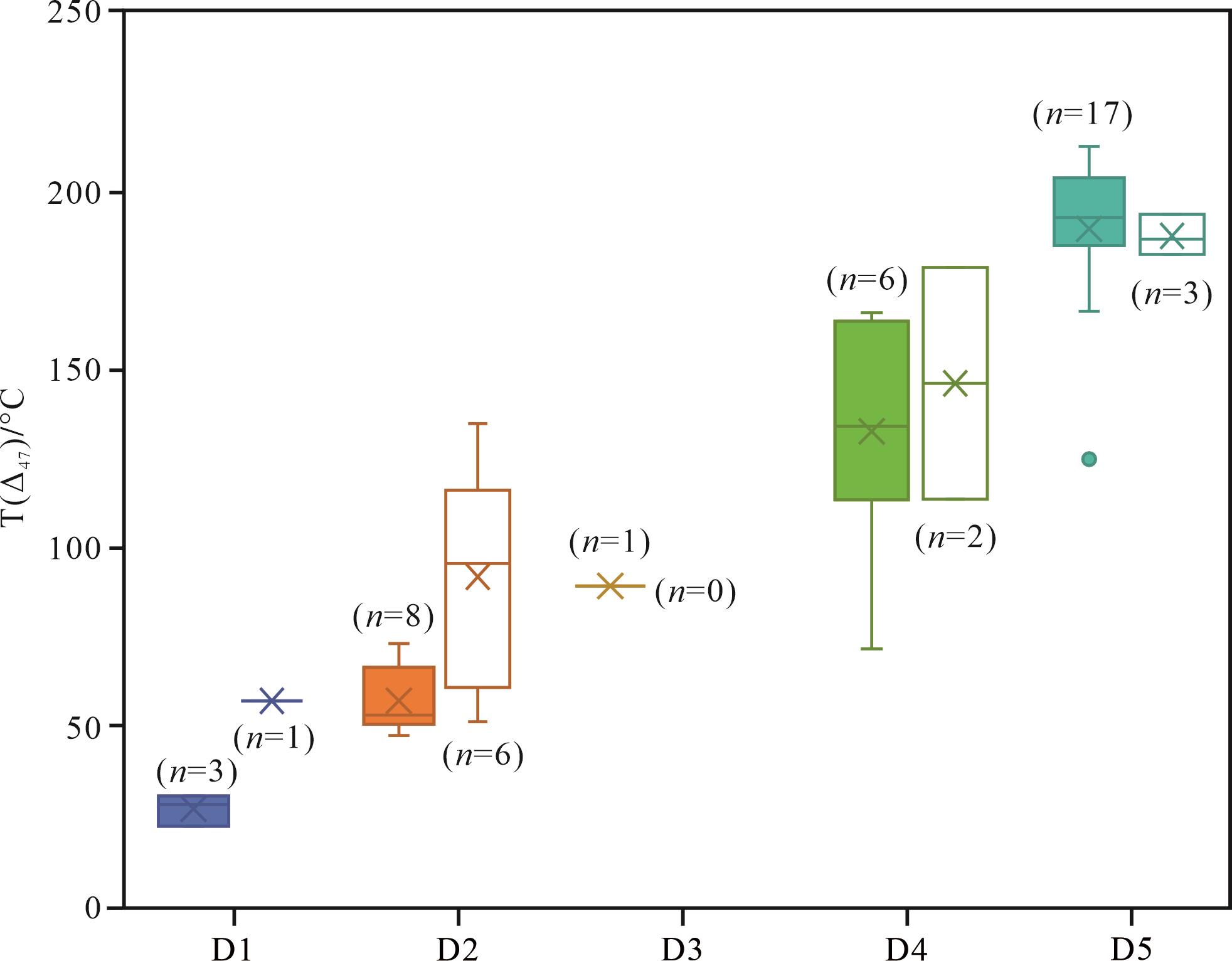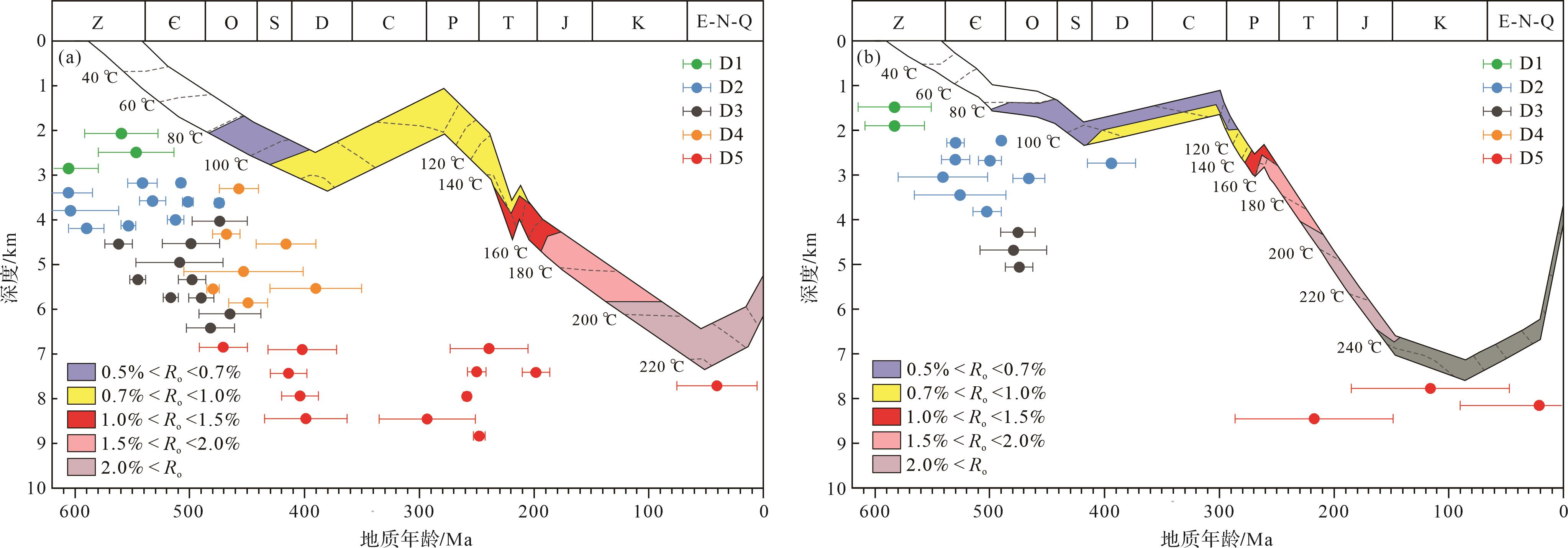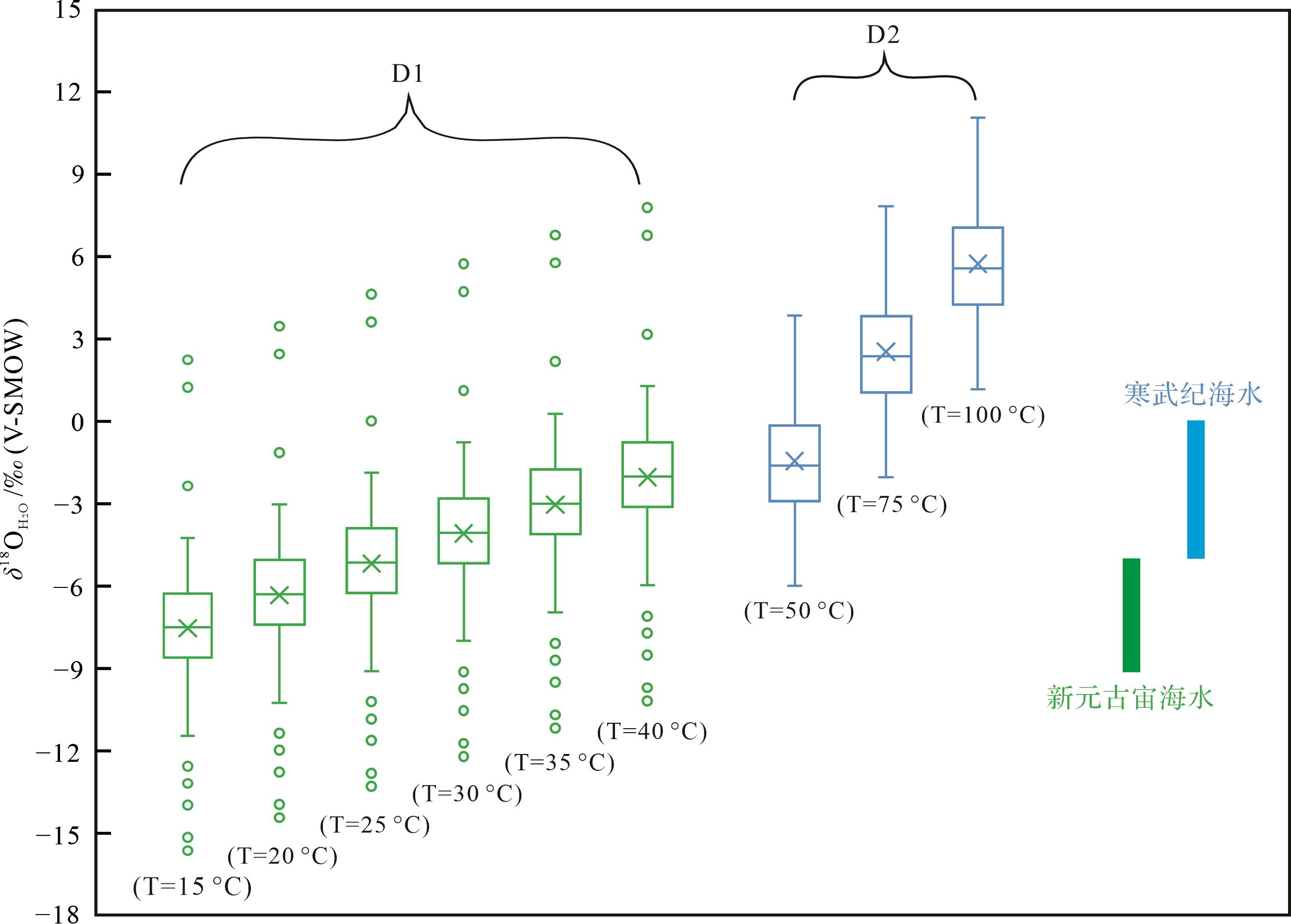HTML
-
深层—超深层油气勘探是中国深地探测战略实施的关键领域,也是国家能源安全保障体系的重要支撑[1⁃4]。四川盆地是我国深层—超深层油气勘探的主战场之一,也是我国最早开展超深层油气勘探实践的区域[1]。近年来,四川盆地的深层—超深层油气勘探取得了丰硕成果,相继发现了多个大型深层—超深层油气田,如蓬莱气田、高石梯龙王庙组大气田、元坝长兴组礁滩气田等[2⁃3,5⁃8],这些发现表明四川盆地的超深层油气勘探具有巨大潜力。四川盆地埃迪卡拉系灯影组主要由一套含藻白云岩组成,具有时代老、埋藏深的显著特征,是四川盆地深层—超深层油气勘探的重要层位。然而,受四川盆地多旋回构造演化的影响[9],灯影组白云岩储层遭受了强烈的后期改造,这种改造极大地增强了储层非均质性,加大了储层预测与评价的挑战性,但也为深层—超深层白云岩储层发育机理研究提供了良好的研究对象。
对于大多数沉积盆地而言,其地层系统内约20%空间都被孔隙流体所占据[10⁃11]。常见的孔隙流体包括水、液态烃、天然气以及它们的混合流体,但普遍而言,沉积盆地内的孔隙流体以水为主[12]。海相沉积盆地内孔隙水的来源多样,但以海水、大气水、结晶水(矿物脱水释放的水)、初生水(岩浆热液)为主[12⁃13]。孔隙水的盐度普遍接近或高于海水盐度,表现为典型的盐水特征[11,14]。但是,在沉积物的埋藏过程中,孔隙水的特征与组成受水—岩作用、温压变化、多源流体混合等影响而不断演化[12]。这种动态演化的孔隙流体对储层的改造作用不可忽视,尤其是对于深层—超深层地层而言,其沉积时代老、地层埋藏深、构造演化复杂等内在属性导致沉积盆地内盐水流体活动可能具有多期次、区域差异性、成分复杂性、流体来源多元性等特征。因此,对深层—超深层储层内盐水流体活动和演化的研究是揭示深层—超深层油气储层形成机制的关键环节之一。
鉴于此,本研究以川中古隆起埃迪卡拉系灯影组为主要研究对象,在汇总前人矿物学、碳—氧—锶同位素地球化学、团簇同位素、白云石U-Pb年代学数据的基础上,系统开展了灯影组的盐水流体活动主要产物成因、盐水流体充注期次和成储意义研究。相关研究成果有望深化对深层—超深层白云岩储层形成与演化机制的理解,为深层—超深层油气勘探与开发提供地质依据。
-
川中古隆起位于四川盆地中西部,属于加里东期古隆起。该隆起构造隶属于乐山—龙女寺继承性古隆起体系,基底由前震旦系变质岩和火成岩构成,具有强抗变形特征,整体表现为由西南向东北倾伏的鼻状隆起,轴线呈NE—SW向展布,核部位于雅安—资阳—岳池一线[5,15⁃16]。川中古隆起构造演化历经多期叠加:埃迪卡拉纪—早古生代受桐湾运动Ⅰ幕(灯二段末期)和Ⅱ幕(灯四段末期)影响,灯影组顶部发生区域性抬升剥蚀,形成溶沟、溶洞及葡萄状白云岩[17],同时德阳—安岳凹槽呈“U”形发育,控制台缘丘滩相分异;加里东运动导致奥陶系—志留系普遍缺失,古隆起初步定型;印支期构造轴线向东南迁移,形成威远—资阳古圈闭;喜马拉雅期受印度板块碰撞影响,轴线南移至威远—高石梯地区,核部埋深增至5 000 m,最终定型为北倾单斜低缓褶皱带[15,18⁃19]。
四川盆地埃迪卡拉系灯影组厚300~1 200 m,自下而上划分为四段:灯一段以深灰色泥粉晶白云岩为主,夹薄层石膏岩及泥质条带,属局限台地潮坪相沉积;灯二段为台缘丘滩相富藻白云岩段,发育藻黏结岩、凝块岩及葡萄花边构造,顶部受桐湾Ⅰ幕岩溶作用改造,溶蚀孔洞缝网络广泛发育;灯三段以深灰色泥页岩和砂质白云岩为主,横向相变为凹槽西侧陆棚相暗色页岩与东侧潮间带泥质白云岩,局部含有机质丰度达1.5%~3.0%的烃源岩;灯四段以浅灰色纹层状藻叠层白云岩为特征,顶部受桐湾Ⅱ幕岩溶作用形成溶洞角砾及硅质条带[18,20⁃22]。四川盆地内部灯影组沉积格局受德阳—安岳凹槽控制,凹槽东西两侧发育多期叠置的台缘丘滩复合体,凹槽北段发育大套深水相泥页岩、硅质岩、泥晶白云岩等,凹槽南段则表现为明显的地层侵蚀[23⁃25](图1)。德阳—安岳凹槽南段纵贯川中古隆起,并可将川中古隆起的灯影组划分为凹槽东侧隆起带、凹槽内隆起带和凹槽西侧隆起带三个部分。目前已发现的多个灯影组气田都位于凹槽东侧隆起带和凹槽西侧隆起带内。
-
目前,已有大量学者对川中古隆起灯影组的成岩作用类型与成岩序列开展了详细研究,相关研究所建立的成岩序列基本一致[52⁃58](图2)。总体而言,研究区主要成岩类型包括:泥晶化作用、白云石化作用、白云石胶结作用、溶蚀作用、压实作用、压溶作用、重结晶作用、硅化作用、热液矿物充填作用、沥青充填作用与构造破裂作用(图3)。其中,泥晶化作用是最早发生的成岩作用之一,常表现为碳酸盐岩颗粒表面形成的薄层泥晶套,但主要发育于砂屑白云岩中(图3a),但近期有研究认为泡沫绵层白云岩是颗粒白云岩建设性泥晶化作用和早期选择性溶蚀的综合产物[61]。灯影组的(早期)白云石化作用机制尚在争论中,微生物白云石化、萨布哈白云石化、渗透回流白云石化等都有被提及,但其白云石化发生时间极早(同生期—早成岩期)是目前的共识[39,44,62⁃65]。灯影组藻格架或原始颗粒沉积后,其格架孔和粒间孔常被多期白云石胶结物充填,其形成环境从近地表环境延伸至深埋藏环境,完整充填序列可归纳为:第一期纤维状或泥—粉晶白云石、第二期叶片状或细晶白云石、第三期中—粗晶白云石、第四期鞍状或巨晶白云石充填,但是单一孔洞内仅出现两期或三期胶结物(图3b、图4)。需要注意的是,川中古隆起灯影组白云岩中也有淡水白云石胶结物,多呈粒状(直径多小于0.5 mm)分布在基质白云石间或纤维状/叶片状白云石部分充填的孔隙内,但其含量普遍很低,常被认为是形成准同生期和/或表生期大气淡水胶结作用产物[19,55,66⁃67]。除白云石胶结物外,研究区灯影组内也见方解石、重晶石、石英、萤石、多类金属矿物(闪锌矿、黄铁矿、方铅矿、铅锌矿)等热液矿物与沥青充填:其中,热液矿物常位于第三/四期白云石胶结物充填的残余孔洞内,是成岩晚期产物[19,29,64,68];沥青充填主要存在两期,分别发生在第二期白云石胶结物形成后和第四期鞍状或巨晶白云石形成后[18,32,55,69](图2)。

Figure 2. Representative paragenetic sequence of the Dengying Formation in the central Sichuan paleo⁃uplift (modified from references [59⁃60])

Figure 4. Thin⁃section microphotographs showing the main cements of the Dengying Formation in the central Sichuan paleo⁃uplift
灯影组原始藻格架或颗粒等自进入埋藏期后经历了长期压实、压溶作用,导致颗粒定向排列、破裂、变形等,并形成缝合线等(图3c,d)。此外,重结晶作用、硅化作用与构造破裂作用在灯影组也较为常见。重结晶作用的产物主要为粉晶至细晶白云岩(图3e),少见粗晶白云岩,原始沉积组构识别困难。镜下见粉晶—细晶白云岩内缝合线沿白云石晶体边界压溶,表明重结晶作用可能发生于强烈压溶之前,并且主要发生在中—深埋藏期[70]。研究区灯影组硅化作用多具一定的组构选择性,可见第一/二期白云石胶结物被选择性硅化而第三期白云石胶结物未硅化的现象,表明硅化作用最晚可延伸至第二期白云石胶结物形成后;但也见白云岩整体被硅化的现象(图3e,f)。构造破裂作用形成的裂缝可切割各类胶结物并被白云石、方解石、石英等多类矿物充填(图3f~h),表明其活动时间相对广泛;近期的白云石脉体U-Pb定年显示,川中地区灯影组至少存在桐湾期、加里东晚期、印支早期三期构造破裂活动[71]。
灯影组的溶蚀作用尤为发育,主要分为三类:准同生期溶蚀、表生期溶蚀、埋藏期溶蚀(图3j~l)。受灯影期高频海平面变化的影响,灯影组沉积物周期性短暂暴露并发生准同生期岩溶作用[72]。该期岩溶作用具有明显的组构选择性,可表现为叠层石的顺层溶孔与溶缝(图3j)、砂屑白云岩的铸模孔等[55,73⁃75]。准同生期选择性溶蚀形成的溶洞、溶缝内可见第一期纤维状或泥—粉晶白云石环边发育,表明其形成时间很早[72]。灯影组表生期岩溶作用和桐湾运动构造抬升相关,该期岩溶作用主要发生在灯二段沉积末期与灯四段沉积末期,不具备明显的组构选择性,可形成大型—超大型溶洞、溶沟、暗河沉积以及风化壳等(图3k)。埋藏期溶蚀作用表现为第二至第四期白云石胶结物以及沥青等后期充填物被局部溶蚀(图3c~l),主要与埋藏期酸性流体充注有关,如生烃期有机酸充注与大火成岩省发育期的酸性流体充注[30,66⁃67,76⁃78],该期溶蚀作用对储层储集性能的影响相对较弱。
-
川中古隆起灯影组盐水流体活动的产物多样,但五类白云石在各区均普遍发育,分别为基质白云石(D1)、纤维状或泥—粉晶白云石(D2)、叶片状或细晶白云石(D3)、中—粗晶白云石(D4)、鞍状或巨晶白云石(D5)(图4),分别代表最主要的五期盐水流体活动产物。基质白云石(D1)主要为泥晶白云石(图4a~e),是藻云岩中藻凝块和藻纹层以及泥晶白云岩的主要组成部分,代表最早期的白云石化事件。纤维状或泥—粉晶白云石(D2)包含纤维状白云石胶结物与(粒状)泥—粉晶白云石两个子类型(图4a~d),二者可呈互层状同时出现,但多单独出现,代表第二期主要的盐水流体产物;其中,纤维状白云石胶结物最为常见,主要由沿空隙边缘垂直生长的纤维状白云石(晶体长宽比普遍大于6)组成并呈等厚环带状,环带厚度从数十微米至数毫米皆有发现。叶片状或细晶白云石(D3)可生长于纤维状或泥—粉晶白云石环边之上,也可直接充填于灯影组藻云岩和颗粒云岩的溶蚀孔洞之内,晶体长度普遍介于100~200 μm,可呈不等大的叶片状或不等粒状,其中叶片状白云石相对较少发育,代表第三期主要盐水流体的产物(图4a,b,d,e)。中—粗晶白云石(D4)是第四期主要盐水流体的产物,其晶体普遍大于细晶白云石,晶体长度多大于200 mm,为不规则粒状(图4a~c,e)。中—粗晶白云石(D4)多出现在叶片状或细晶白云石之后,常表现出自孔隙外缘向孔隙中心晶体逐渐增大的特征。鞍状或巨晶白云石(D5)为最晚期盐水流体活动形成,以晶面弯曲、波状消光的鞍状白云石产出为代表特征,少见巨晶白云石,多位于孔隙中心(图4b,c,e,f);从生长次序而言,鞍状或巨晶白云石多生长在叶片状或细晶白云石、中—粗晶白云石之后。
4.1. 矿物类型
-
川中古隆起灯影组不同类型、不同区域白云石的δ13C和δ18O存在差异(图5)。凹槽东侧D1的δ13C和δ18O分别为-0.5‰~3.4‰、-10.8‰~0.9‰;西侧D1的δ13C(-0.8‰~4.3‰)和δ18O(-6.5‰~5.5‰)与东侧基本一致。凹槽东侧D2的δ13C和δ18O为0~3.7‰V-PDB、-8.9~-2.8‰V-PDB;西侧D2的δ13C和δ18O相对较低,分别为-2.0‰~2.7‰、-10.1‰~-0.3‰。凹槽东侧D3的δ13C为-0.6‰~2.6‰,显著高于西侧D3的δ13C(-3.3‰~-1.7‰);δ18O方面,东侧D3介于-10.0‰~-5.4‰,而西侧D3则明显较窄,为-9.7‰~-7.8‰。凹槽东西两侧D4的δ13C范围基本重合,分别为-2.3‰~3.2‰、-1.9‰~2.9‰;δ18O显示东侧变化范围更大(-13.8‰~-5.1‰),西侧相对集中(-12.6‰~-8.8‰)。凹槽东西两侧D5的δ13C和δ18O存在较大差异,东侧δ13C介于-5.4‰~4.0‰,δ18O介于-14.8‰~-6.8‰;而西侧为-1.7‰~3.1‰、δ¹⁸O介于-12.0‰~-3.1‰。

Figure 5. δ13C and δ18O compositions of dolomite cements in the Dengying Formation, central Sichuan paleo⁃uplift
总体而言,德阳—安岳凹槽东侧D1和D2的δ13C相对接近,D3、D4、D5的δ13C则总体略偏负,其中D4和D5存在部分样品的δ13C显著偏负;凹槽东侧白云石的δ18O则表现出从D1至D5逐渐负偏的显著趋势,δ18O从D1的-5.0‰~-3.0‰下降为D5的-12.0‰~-9.5‰(图5b)。相比之下,凹槽西侧不同类型白云石的δ13C变化范围更大,D1至D3总体呈现出δ13C逐渐降低的趋势,但是D4和D5的δ13C却高于D3,且变化范围更大(图5d)。在δ18O方面,凹槽西侧同样表现出从D1至D4逐渐负偏的总体趋势,但至D5时,δ¹⁸O的分布范围进一步扩大,部分样品的δ¹⁸O值明显高于D4型,表现出一定程度的正偏特征(图5d)。
-
统计分析显示研究区灯影组白云石的87Sr/86Sr介于0.707 789~0.715 231,平均值为0.710 253(图6)。凹陷东侧D1的87Sr/86Sr普遍介于0.708 000~0.711 000,西侧D1的87Sr/86Sr主要介于0.708 500~0.709 000。凹陷东侧和西侧D2的87Sr/86Sr范围较小,分别介于0.708 645~0.709 023、0.708 820~0.710 144,西侧D2的87Sr/86Sr相对较高。凹陷东侧D3的87Sr/86Sr介于0.708 703~0.711 800,较D2显著增高且范围变大。凹陷东侧D4与D3的87Sr/86Sr范围基本重合,介于0.708 703~0.711 800,凹槽西侧D2的87Sr/86Sr则介于0.709 030~0.709 750。研究区D5的87Sr/86Sr变化范围极大,其中凹槽东侧D5的87Sr/86Sr介于0.708 566~0.714 959,与D4局部重合;凹槽西侧D5的87Sr/86Sr介于0.710 059~0.715 231,显著高于同区D4的87Sr/86Sr。

Figure 6. 87Sr/86Sr compositions of different dolomites from the Dengying Formation in the central Sichuan paleo⁃uplift, compared with the 87Sr/86Sr ranges of the Ediacaran and Cambrian seawater[79] (solid box plots and hollow box plots present data from the eastern and western sides of the Deyang⁃Anyue intracratonic sag, respectively)
-
研究区各类白云石的团簇同位素数据较少,但基于团簇同位素重建的成岩温度[T(Δ47)]总体表现出从D1至D5逐渐升高的趋势(图7)。其中,凹陷东侧D1至D5的T(Δ47)温度分别为21.7 ℃~30.2 ℃、47.2 ℃~73.1 ℃、89.3 ℃、71.6 ℃~166.2 ℃、125 ℃~213 ℃;凹陷西侧D1、D2、D4、D5的T(Δ47)温度分别56.9 ℃、51 ℃~135 ℃、113.7℃~179 ℃、182.7 ℃~194 ℃。
-
白云石U-Pb同位素定年数据显示,各期白云石的形成年龄具有显著差异(图8)。凹槽东侧D1的U-Pb年龄为607±21 Ma~548±21 Ma,西侧为584±24 Ma。D2的U-Pb年龄约小于D1,东侧为781±21 Ma~474±3.7 Ma,主要介于600~500 Ma;西侧为557±39 Ma~410±21 Ma,多介于550~500 Ma。凹槽东侧和西侧D3的U-Pb年龄分别为545.4±6.9 Ma~465±27Ma、486±29 Ma~481±12 Ma。凹槽东侧D4的U-Pb年龄介于479.6±5.4 Ma~390±40 Ma,凹槽西侧D4的U-Pb年龄缺乏。D5的U-Pb年龄范围极大,凹槽东侧为472±21 Ma~41±35 Ma,凹槽西侧为216.4±7 Ma~20±130 Ma。
4.3. 锶同位素组成
4.4. 团簇同位素
4.5. U⁃Pb同位素定年
-
深层—超深层白云岩储层通常经历了复杂的构造变形、埋藏演化及多阶段成岩作用过程,使其白云石化特征表现出显著的多期性,且随着埋藏深度的增加和层系的变老,白云石化作用的期次愈加繁多,演化过程亦趋复杂[46,82]。本次的数据汇编分析显示,川中古隆起灯影组五期白云石的成岩流体和成岩环境存在显著差异。
D1的δ13C主要介于1.0‰~3.0‰,介于同期海相碳酸盐岩的δ13C范围(0~6.0‰)[83],U-Pb年龄在607±21 Ma和548±21 Ma之间,属于埃迪卡拉纪晚期,表明D1的白云石化流体可能主要为同期海水[84]。凹陷东侧D1的T(Δ47)介于21.7 ℃~30.2 ℃,西侧则为56.9 ℃,其中东侧D1的T(Δ47)为经过成岩恢复排除高温导致的δ13C-δ18O固态重排后的数据[15],可信度最高。埃迪卡拉纪全球海水温度介于18 ℃~38 ℃[85],而川东地区灯影组石盐矿物中的流体包裹体温度主要介于20 ℃~25 ℃[86],对比表明同期海水在并未经历深循环升温或其他升温过程的情况下就导致了D1的形成。为明确形成D1的海水是否经历了显著蒸发作用,我们利用传统O同位素温度计[87]和D1的δ18O值,分别计算了白云石化流体在20 ℃、25 ℃、30 ℃情况下的δ18OH2O值。结果显示恢复的D1白云石化流体的δ18OH2O分别介于-7.5‰~-5.0‰、-6.0‰~-3.5‰和-5.0‰~-2.5‰(图9),而新元古宙海水的δ18OH2O低于-5.0‰[88],表明形成D1并未经历显著的蒸发作用。综合证据表明D1的形成是海水白云石化的产物,但具体是微生物白云石化、(未强烈蒸发海水的)渗透回流白云石化或其他模式有待明确。另外,需注意的是多数D1的87Sr/86Sr略高于埃迪卡拉纪海水,这可能与富放射性87Sr细碎屑物质的注入有关。灯影组沉积期,四川盆地北部发育汉南古陆[90],凹槽东侧D1更高的87Sr/86Sr可能与该区域更靠近汉南古陆相关;同时,较深水凹槽的存在也在一定程度上阻碍了细碎屑物质向德阳—安岳凹槽西侧的运移。

Figure 9. Calculated δ18OH2O of the dolomitization fluids for the matrix dolomite (D1) and fibrous or micrite to very fine⁃crystalline dolomite (D2) in the Dengying Formation of the central Sichuan paleo⁃uplift at different temperatures, compared with the δ18OH2O ranges of the Neoproterozoic and Cambrian seawater
U-Pb定年显示D2与D1同期形成或略晚(多在600~500 Ma,即埃迪卡拉纪—寒武纪苗岭统),表明其可能为同生期或早成岩期的产物。D2的δ13C与87Sr/86Sr显示出与D1相似的组成,表明其成岩流体同样主要为海水。D2的T(Δ47)多介于50.0 ℃~100 ℃,解楠[15]经过成岩恢复后的纤维状白云石胶结物的T(Δ47)为73.1 ℃,高于埃迪卡拉纪至寒武纪海水温度[85],表明原始海水可能存在增温现象。利用传统O同位素温度计[87]计算D2成岩流体在50 ℃、75 ℃、100 ℃时的δ18OH2O多分别为-3.0‰~0、1.5‰~3.5‰和4.5‰~7.5‰(图9),比新元古宙海水的δ18OH2O(低于-5.0‰)[88]高出2.0%以上,与寒武纪海水的δ18OH2O(-5.0‰~0)[90]局部重合。相比于海水更高的δ18O可能与蒸发作用导致的残余海水中的18O富集相关[91]。现代海洋中,进入石膏沉淀区的海水通常比正常海水的δ18OH2O高3‰~6‰[92]。对比表明,研究区D2计算的成岩流体盐度范围较广,可能包括盐度接近原始海水的流体,也包括经过强蒸发的中—高盐度海源卤水。这一推测符合研究区的沉积背景:研究区从埃迪卡拉纪至中寒武世经历了碳酸盐岩台地—深水陆棚—碳酸盐岩缓坡—碳酸盐岩蒸发台地的演化,能为D2的形成提供正常盐度海水至高盐度卤水。综上,D2可能与早成岩期(蒸发)海水来源的孔隙水相关。但需要注意的是,D2以纤维状白云石为主,而灯影组的纤维状白云石存在正、负两类延性,分别指示原生沉淀与次生交代白云石[31,93⁃95]。因此,D2既包括早成岩期的孔隙水胶结作用的产物,也包括其(拟晶)白云石化的产物。
凹槽东侧D3的δ13C范围与D1和D2存在部分重叠,但整体相对略低(差值在2.0‰以内),同时其87Sr/86Sr范围与D1和D2部分重叠但略高;凹槽西侧D3的δ13C数据过少,87Sr/86Sr数据缺少,指示意义较差,不作深入分析。这种与D1相似的δ13C、87Sr/86Sr组成表明:(1)D3的形成可能与D1、D2具有类似的成岩流体(即海水),(2)D3的形成可能是埋藏作用过程中D1和D2溶解再沉淀的结果。其中,前者的可能性较小,因为:(1)研究区D3的U-Pb定年年龄多介于520~ 470 Ma,主要为中寒武世至早奥陶世的产物,此时灯影组埋深已超过1 000 m(图8),海水很难下渗至如此深度;(2)研究区在中寒武世演化为均一碳酸盐岩台地内的台内环境[96],早奥陶世川中古隆起虽开始发育但未发生显著变形,主要表现为同沉积古隆起[97],因此研究区中寒武世至中奥陶世不太可能存在大断裂直接连通灯影组与地表;(3)上覆寒武系麦地坪组—筇竹寺组是一套深水—较深水相沉积[96],渗透性极差,是一套天然的隔水层。此外,D3的T(Δ47)为89.3 ℃,处于研究区灯影组在中寒武世至中奥陶世期间的地层温度范围(50 ℃~95 ℃)之内(图8),说明D3的形成未受外来热液的影响。因此,D3最可能是D1和D2在埋藏过程中发生溶解,并在局部适宜环境中再沉淀的产物。
D4与D3在δ13C与87Sr/86Sr范围上基本一致,表明D4的成岩流体可能与D3类似。D4与D3的δ18O局部重合,但整体更为偏负,这可能与其更晚的形成时代(多介于470~410 Ma,即中寒武世—晚志留世)、相对更深的形成深度以及更高的成岩流体温度有关。D4的T(Δ47)多介于110 ℃~160 ℃,经过成岩恢复后的D4的T(Δ47)介于127.8 ℃~166.2 ℃[15],显著高于D3的成岩流体温度[T(Δ47)=89.3 ℃],验证了D4较D3形成于更加高温的成岩流体中。但是,需要注意的是D4形成期(即中寒武世—晚志留世)灯影组在凹陷东西两侧的地层温度均介于50 ℃~120 ℃(图8),显著低于D4的T(Δ47)温度,表明D4的形成受到外源高温热液的影响。这种热液的输入可能与局部断裂活动或者晚奥陶世—晚泥盆世川中古隆起区域性剧烈抬升变形相关[97]。因此,D4可能是中埋藏期D1~D2溶解后形成的流体与高温热液混合所沉淀的产物,但鉴于团簇同位素数据有限且不同区块埋藏史存在差异,部分D4可能未受到高温热液的影响。
D5的δ13C、δ18O、87Sr/86Sr较D1~D4均出现了明显的变化,表明其成岩流体与D1~D4明显不同。D5的87Sr/86Sr与D3和D4局部重合,但整体显著高于D1和D2,说明其Sr来源可能具有明显的多源性或它源性,而不仅仅来自早期大量形成的D1和D2溶解所产生的流体。D5的δ18O较D1~D4显著降低,指示更高的成岩温度,这得到了其接近200 ℃的T(Δ47)温度的验证(图8)。前期有研究认为,川中古隆起的鞍状白云石主要与加里东期构造活动、峨眉大火成岩活动以及燕山期构造活动导致的热液活动相关[32,36]。构造活动期的断裂发育能够显著增强深部热液向灯影组的运移,为其提供了富含放射性⁸⁷Sr的热流体,这较好地解释了研究区D5所表现出的低δ18O、高87Sr/86Sr的特征[29,32,36,82]。然而,本次汇总的D5的U-Pb年龄显示其形成时间跨度为472 Ma至20 Ma,说明D5并不具备明确的时间指示意义,深部热流体的充注与D5的沉淀过程可能持续贯穿奥陶纪至新生代。不过从年龄数据的整体分布来看,晚二叠世(峨眉大火成岩省事件)是凹槽东侧D5的集中形成期。本次汇总的D5 U-Pb年龄数据的另一个显著特征是在中泥盆世至晚石炭世时期缺乏D5形成的年龄记录(图8)。从川中古隆起的演化来看,志留纪末—石炭纪是川中古隆起的强烈隆升剥蚀阶段[97⁃98],大规模抬升的同时必然诱发大量的断裂活动而有利于深部热液向灯影组的运移。但是,D5的缺失表明该时期灯影组并未发生大规模热液充注活动。这种热液充注的缺失可能受两方面因素的影响:(1)大规模抬升(近千米地层被剥蚀)导致灯影组深度抬升近千米[97],抬升后的地下热液潜水面可能低于灯影组埋藏位置;(2)晚志留世—晚石炭世,川中古隆起及其周缘地区整体隆升形成古陆[99],地表海水缺乏,海水经大断裂向深部充注的活动受限。综上所述,研究区D5的形成可能主要受奥陶纪以来富含放射性⁸⁷Sr的深部热液流体长期持续充注的控制。
-
盐水流体活动伴随着沉积岩形成和演化的整个过程,对其作用和表现形式随埋藏深度及环境变化而动态演化。川中古隆起灯影组是四川盆地深层—超深层油气勘探的重点,五期盐水流体活动通过两阶段差异化成岩作用影响着灯影组储层演化:早期盐水充注活动产生的建设性成岩作用、中晚期盐水流体活动导致的破坏性成岩作用。
沉积岩的储集性能受压实与压溶作用的影响极大[100⁃101]。碳酸盐沉积物在浅层时的初始孔隙度可达50%~70%。然而,随着埋藏深度的增加,尤其在埋藏深度超过6 000 m时,其孔隙度可大幅降低接近于0[101]。因此,拥有抗压实格架的碳酸盐岩常能保留较好的孔隙,是深层—超深层油气勘探的关注重点。较灰岩而言,白云岩具有更强的物理硬度和化学稳定性,因此具有更强的抗压实—压溶能力[102⁃103]。深埋藏的白云岩储层与灰岩储层虽然在渗透率上差异不大,但前者却表现出更高的孔隙度[104]。研究显示,对于初始孔隙度较大的碳酸盐岩而言,其在埋藏阶段压实作用导致的孔隙度锐减主要集中发育在1 000 m深度范围内(即浅埋藏期早期)[102]。对于研究区灯影组储层而言,浅埋藏期主要发育了两期盐水流体活动(图8)。其中,第一期盐水流体活动发生在灯影组沉积期并导致了整个上扬子台地发生规模性早期白云石化,在台地边缘带形成了物性良好、具较强抗压实—压溶能力的丘滩相白云岩。第二期盐水流体活动在(溶蚀)孔洞周缘形成了D2,此类胶结物的形成一方面部分填充了孔隙降低了储层品质,另一方面也将各类藻组构、颗粒等紧密胶结在一起,进一步增强了丘滩白云岩储层的抗压实—压溶能力。从川中蓬莱气田的统计来看,D2仅占据储集空间的20%以下[55,64],对储层的破坏效应相对有限;相反,蓬莱气田灯二段的岩心显示,在保存较好的溶缝(洞)周围普遍发育D2[105],表明第二期盐水流体活动可能更多地表现为增强储层的抗压实—压溶能力。
D3~D5多形成在1 000 m以下的中埋藏—深埋藏环境(图8),此时压溶作用已成为最主要的减孔方式[101⁃102]。压溶作用的大量发生导致早期D1、D2部分溶解,使得孔隙内流体变成白云石过饱和状态(即第三期盐水流体),并沿着残余储集空间周缘沉淀D3。本次盐水流体活动对灯影组储层的破坏作用最大,川中蓬莱地区D3多占到储集空间的50%以上[55,64]。随着埋藏的不断加深,压溶作用持续活动的同时,外源高温热液也沿着断裂带运移而来,并形成了D4和D5,一定程度上破坏了储集空间。但是,D4、D5占据储集空间的比例普遍小于20%,对储层的破坏作用较弱。这种D3和D4~D5对储层的差异性破坏作用可能与二者形成期的差异性压溶作用相关。高孔隙度碳酸盐岩的孔隙度锐减主要集中在埋深2 000 m的范围,而压溶作用发生在埋深500~800 m后[101⁃102]。这使得埋深在800~2 000 m的范围可能是主要的压溶再沉淀期。结合白云石U-Pb定年来看,800~2 000 m正好是D3主要形成期,快速的压溶为D3的形成提供了物质基础。相比之下,D4~D5多形成于2 000 m深度以下(图8),持续的埋藏虽然会导致压溶作用的进行,但其压溶强度存在显著减弱,地层内部对胶结作用发生所需的Ca、Mg等离子供给明显减弱。此外,川中地区灯影组在进入埋藏后一直处于相对封闭的环境,不存在大规模流体注入,外源Ca、Mg等离子的供给也相对缺乏。这一系列因素共同作用,最终使得D4~D5的发育程度明显低于D3,减孔作用相对较弱,对储层的影响相对较小。
总体而言,川中古隆起灯影组白云岩储层的演化受两阶段盐水流体活动所主导的差异化成岩作用影响。沉积期至浅埋藏期的广泛盐水流体活动驱动大规模白云石化作用和早期白云石胶结作用,形成D1和D2,显著提升了储层的抗压实—压溶能力。中埋藏—深埋藏期的流体活动,表现出明显的储层破坏性:其中,中埋藏早期的盐水流体活动形成大量的D3堵塞孔隙,导致储集空间显著减少,为主要破坏阶段;中埋藏晚期至深埋藏期由于流体供给有限、体系相对封闭,仅形成少量的D4和D5,对白云岩储层的改造作用较弱。
5.1. 多期白云石的成岩流体与成岩环境
5.2. 盐水流体活动的成储效应
-
(1) 川中古隆起灯影组主要发育五类白云石:基质白云石(D1)、纤维状或泥—粉晶白云石(D2)、叶片状或细晶白云石(D3)、中—粗晶白云石(D4)、鞍状或巨晶白云石(D5)。五类白云石在δ13C、δ18O、87Sr/86Sr、T(Δ47)和U-Pb年龄上存在一定差异,分别代表五期化学性质和形成时代各异的盐水流体活动产物。
(2) 川中古隆起灯影组各类白云石的成岩流体和成岩环境存在显著差异:D1形成于埃迪卡拉纪晚期,主要为未经历强烈蒸发作用的海水白云石化产物;D2形成于埃迪卡拉纪晚期—寒武纪,属于早成岩期(蒸发)海水渗透回流白云石化的产物;D3多形成于中寒武世—早奥陶世,为中埋藏早期D1和D2在发生溶解后再沉淀的产物;D4多形成于中寒武世—晚志留世,主要为中埋藏期D1~D2溶解后形成的流体与高温热液混合所沉淀产物;D5形成期横跨奥陶纪至新生代,其形成可能主要与奥陶纪以来富含放射性⁸⁷Sr的深部热液流体长期持续充注有关。
(3) 川中古隆起灯影组的盐水流体活动通过两阶段差异化成岩作用影响着灯影组深层—超深层白云岩储层演化。早期盐水流体活动促成大规模白云石化形成D1和D2,增强了储层抗压实—压溶能力,具有建设性作用;而中晚期盐水流体活动形成的D3、D4和D5则破坏了残余储集空间,尤其以中埋藏早期的第三期盐水流体破坏性最强,而中埋藏晚期—深埋藏期的第四、五期盐水流体活动因体系相对封闭与流体注入有限,影响相对较弱。

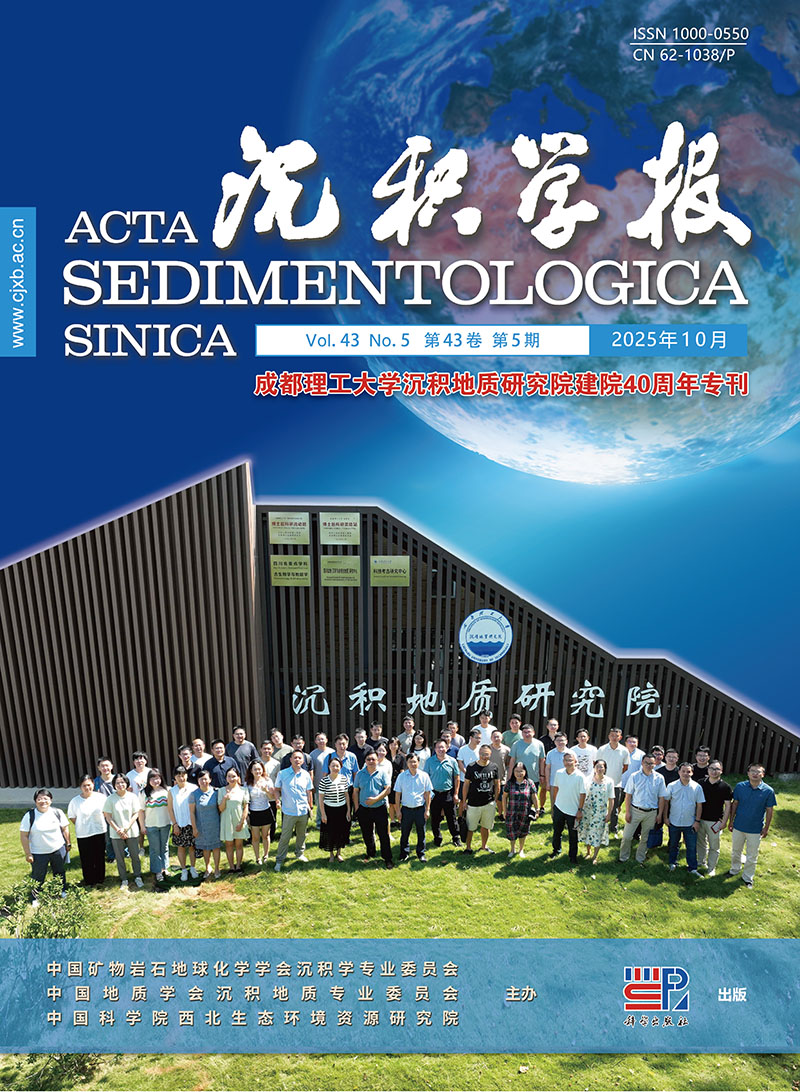


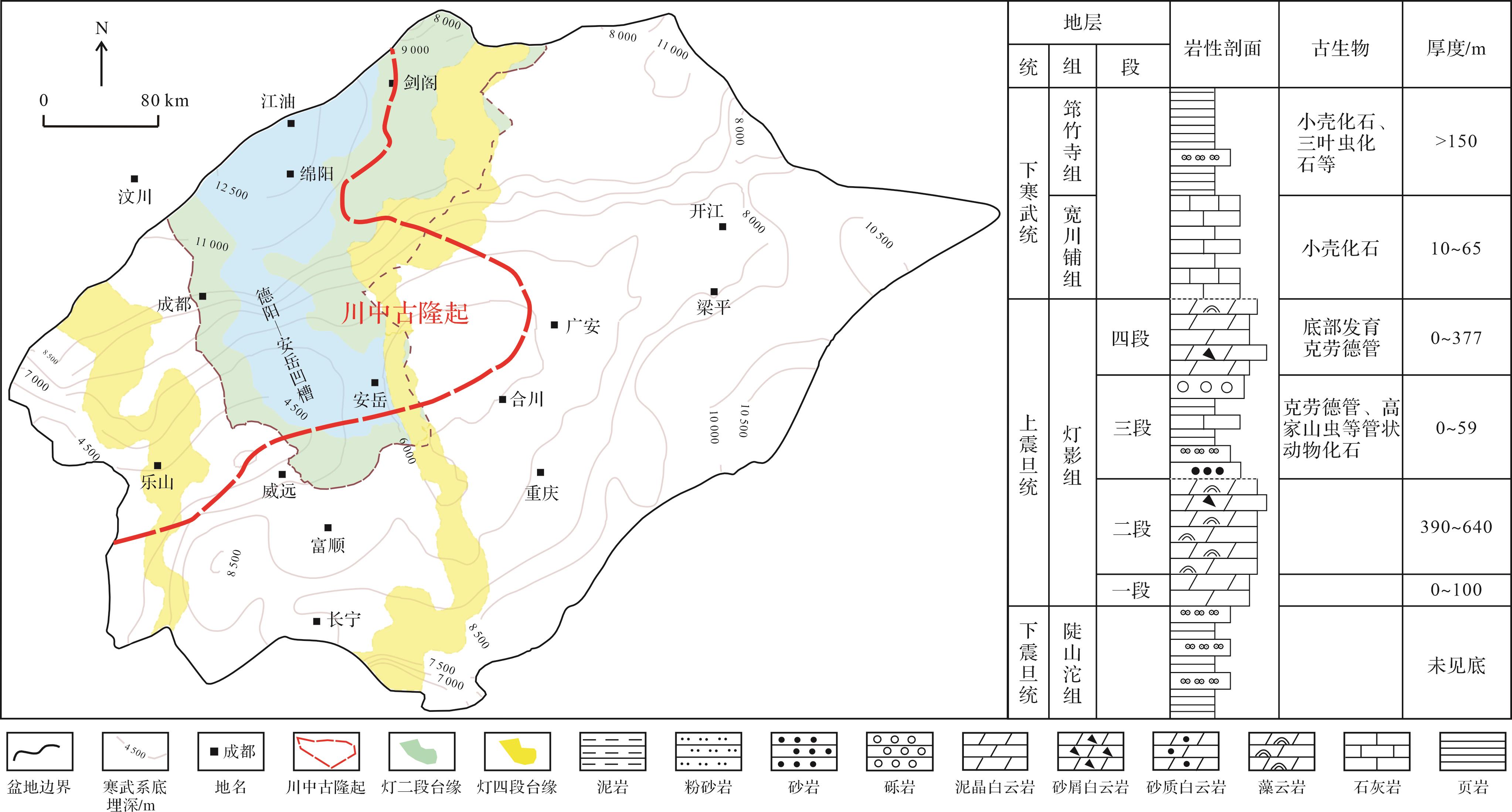






 DownLoad:
DownLoad:
